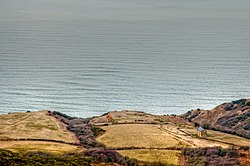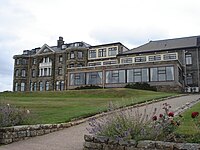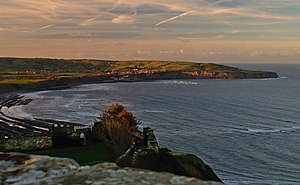Ravenscar
| Ravenscar | |
| Yorkshire North Riding | |
|---|---|
 Ravenscar from above | |
| Location | |
| Grid reference: | NZ980014 |
| Location: | 54°23’58"N, 0°29’31"W |
| Data | |
| Post town: | Scarborough |
| Postcode: | YO13 |
| Local Government | |
| Council: | North Yorkshire |
| Parliamentary constituency: |
Scarborough and Whitby |
Ravenscar is a coastal village in the North Riding of Yorkshire, within the bounds of the North York Moors National Park, ten miles north of Scarborough.
A National Trail, the 110-mile Cleveland Way, passes through Ravenscar, which is also the eastern terminus of the Lyke Wake Walk. The official end of the walk is at a point where the path meets the coast road.
History
Ravenscar was the location of a late 4th century Roman signal station – part of a chain that extended along the Yorkshire coast.[1]
To the north of the village is the old Peak alum works,[2] now a National Trust site, but once an important part of the dyeing industry. The last alum works at Ravenscar closed down in 1871 after the invention of a synthetic dye fixer.[3]
At the edge of the village is a disused windmill, Peak Mill, which dates from 1858.[4]
Until the early 20th century Ravenscar was known as 'Peak' or 'The Peak'.[5]
At the turn of the 19th–20th century, plans were made to turn the village into a holiday resort to rival nearby Scarborough. Roads were laid out, some houses were built and sewers were laid. Because of the long trek to its rocky beach, Ravenscar never achieved popularity, and the development was left unfinished – a town with sewers and streets but no houses.[6]
The village was served by Ravenscar railway station between 1885 and 1965.[7]
Peak House/Raven Hall
In 1540, a farm known as Peak House owned by the Beswick family occupied the site of a 5th-century Roman fort. In 1774 Raven Hall was built on the site for Captain William Childs of London, a captain in the King's Regiment of Light Dragoons, who came to Yorkshire with the army and became the owner of the Alum Works at Ravenscar. On his death in 1829 the hall passed to his daughter Ann Willis, whose family (headed by Dr Francis Willis) had become wealthy from treating George III and other royalty for their medical conditions. Ann's son, the eccentric Rev Dr Richard Willis, built the gardens and battlements which surround the house. In 1845 the property passed into the hands of William Hammond of London.
Hammond became a prominent local benefactor, building the village church and the windmill. He became a director of the Scarborough to Whitby railway line, insisting that it passed through his property via a tunnel and that Ravenscar should have a station.
On his widow's death in 1890 the estate was sold to the Peak Estate Company for development as a holiday resort. The house was extended for use as a hotel from 1895, and its golf course opened in 1898. It was sold by auction in 1911 after the company went bankrupt, and after several changes of ownership and use as a billet in wartime it was acquired by the present owners, who are associated with Classic Hotels.[8]
Outside links
| ("Wikimedia Commons" has material about Ravenscar) |
References
- ↑ Rhodes, Simon (1998). Ravenscar. The Town That Never Was. SMaRt Publications. ISBN 978-0-9531033-1-7.
- ↑ The Science at Peak Alum works.
- ↑ Behrens, David (3 November 2018). "Ghosts on the coast". The Yorkshire Post (Country Week): p. 13. SSN 0963-1496.
- ↑ Whitworth, Alan (2002). Tyke Towers Yorkshire's Windmills. Landy Publishing. ISBN 1 87289557 3.
- ↑ A History of the County of York: North Riding - Volume 2 pp 476-483: Parishes: Scalby (Victoria County History)
- ↑ "Rosyth to Hull". Coast. BBC2. 1 September 2009. No. 8. 42 minutes in.
- ↑ "Disused Stations: Ravenscar Station". http://www.disused-stations.org.uk/r/ravenscar/. Retrieved 9 October 2018.
- ↑ "Raven Hall-History". http://www.ravenhall.co.uk/page/history.html. Retrieved 19 August 2013.


